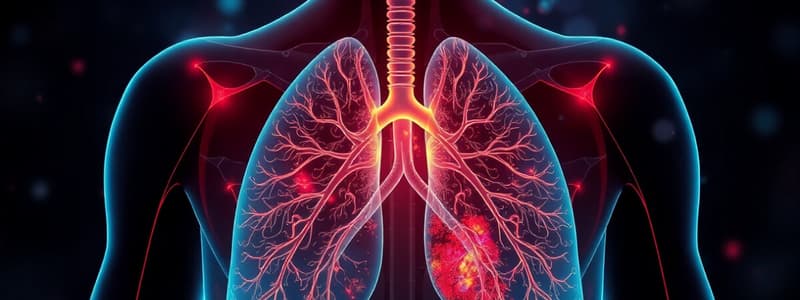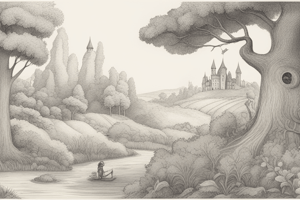Podcast
Questions and Answers
What is the primary role of the diaphragm in the respiratory system?
What is the primary role of the diaphragm in the respiratory system?
- To control the amount of oxygen in the blood
- To act as a passageway for food
- To filter air entering the lungs
- To facilitate inhalation and exhalation (correct)
Which structure connects the nasal cavity to the larynx?
Which structure connects the nasal cavity to the larynx?
- Trachea
- Pharynx (correct)
- Larynx
- Alveoli
What occurs during the process of external respiration?
What occurs during the process of external respiration?
- The diaphragm relaxes to increase lung volume
- Oxygen is absorbed by tissues
- Air is expelled from the lungs
- Gas exchange occurs between alveoli and blood (correct)
Which of the following is NOT a function of the respiratory system?
Which of the following is NOT a function of the respiratory system?
Adult lungs contain approximately how many alveoli?
Adult lungs contain approximately how many alveoli?
Which condition is characterized by inflammation and narrowing of airways?
Which condition is characterized by inflammation and narrowing of airways?
What is the main pathway for air to travel from the larynx to the lungs?
What is the main pathway for air to travel from the larynx to the lungs?
Which respiratory process involves the movement of air in and out of the lungs?
Which respiratory process involves the movement of air in and out of the lungs?
Study Notes
Overview of the Respiratory System
- The respiratory system is responsible for gas exchange, supplying oxygen to the body and removing carbon dioxide.
- Major components include the lungs, airways, and respiratory muscles.
Key Structures
-
Nasal Cavity
- Warms, moistens, and filters air.
- Contains mucus and cilia to trap particles.
-
Pharynx (Throat)
- Connects nasal cavity to larynx.
- Divided into nasopharynx, oropharynx, and laryngopharynx.
-
Larynx (Voice Box)
- Contains vocal cords.
- Acts as a passageway for air and prevents food from entering the trachea.
-
Trachea (Windpipe)
- Connects larynx to bronchi.
- Supported by cartilage rings; lined with cilia and mucus.
-
Bronchi and Bronchioles
- Bronchi are the main air passages dividing from the trachea into each lung.
- Bronchioles are smaller branches leading to alveoli.
-
Alveoli
- Tiny air sacs where gas exchange occurs.
- Surrounded by capillaries for oxygen and carbon dioxide exchange.
-
Lungs
- Main organs of respiration.
- Right lung has three lobes; left lung has two lobes.
-
Diaphragm
- Primary muscle for breathing.
- Contracts to allow inhalation and relaxes during exhalation.
Functions
- Inhalation: Diaphragm contracts, increasing thoracic cavity volume; air is drawn in.
- Exhalation: Diaphragm relaxes, reducing thoracic cavity volume; air is expelled.
- Gas Exchange: Oxygen is absorbed; carbon dioxide is released via diffusion in alveoli.
Respiratory Processes
- Ventilation: Movement of air in and out of the lungs.
- External Respiration: Exchange of gases between alveoli and blood.
- Internal Respiration: Exchange of gases between blood and body tissues.
Regulation of Breathing
- Controlled by the respiratory center in the brain (medulla oblongata and pons).
- Responds to CO2 levels, O2 levels, and pH of blood.
Common Disorders
- Asthma: Inflammation and narrowing of airways.
- Chronic Obstructive Pulmonary Disease (COPD): Includes chronic bronchitis and emphysema.
- Pneumonia: Infection causing inflammation in the alveoli.
- Lung Cancer: Abnormal cell growth in lung tissues.
Important Facts
- Adult lungs contain about 300 million alveoli.
- The surface area of alveoli is roughly the size of a tennis court.
- The respiratory system also plays roles in speech, smell, and regulating body temperature.
Overview of the Respiratory System
- Responsible for gas exchange: supplying oxygen and removing carbon dioxide.
- Composed of lungs, airways, and respiratory muscles.
Key Structures
- Nasal Cavity: Warms, moistens, and filters air; features mucus and cilia for trapping particles.
- Pharynx: Connects nasal cavity to larynx; divided into nasopharynx, oropharynx, and laryngopharynx.
- Larynx: Houses vocal cords; acts as an air passage and prevents food from entering the trachea.
- Trachea: Connects larynx to bronchi; supported by cartilage rings, lined with cilia and mucus for protection.
- Bronchi and Bronchioles: Main air passages branching from the trachea; bronchioles lead to alveoli for gas exchange.
- Alveoli: Tiny air sacs where oxygen and carbon dioxide are exchanged; surrounded by capillaries.
- Lungs: Main organs for respiration; right lung has three lobes, left lung has two lobes.
- Diaphragm: Primary muscle for breathing; contracts during inhalation and relaxes during exhalation.
Functions
- Inhalation: Diaphragm contracts, increasing thoracic cavity volume and drawing air in.
- Exhalation: Diaphragm relaxes, decreasing thoracic cavity volume and expelling air.
- Gas Exchange: Oxygen absorbed and carbon dioxide released in the alveoli through diffusion.
Respiratory Processes
- Ventilation: The process of air moving into and out of the lungs.
- External Respiration: Gas exchange occurring between alveoli and blood.
- Internal Respiration: Gas exchange between blood and body tissues.
Regulation of Breathing
- Controlled by the respiratory center in the brain, specifically the medulla oblongata and pons.
- Adjustments made in response to carbon dioxide and oxygen levels as well as blood pH.
Common Disorders
- Asthma: Characterized by inflammation and narrowing of airways, leading to difficulty breathing.
- Chronic Obstructive Pulmonary Disease (COPD): Encompasses chronic bronchitis and emphysema, damaging airflow.
- Pneumonia: Infection leading to inflammation of the alveoli, affecting gas exchange.
- Lung Cancer: Involves abnormal cell growth in lung tissues, impacting respiratory function.
Important Facts
- Adult lungs contain approximately 300 million alveoli, providing a large surface area for gas exchange.
- The total surface area of alveoli is roughly equivalent to the size of a tennis court.
- The respiratory system is also involved in speech, sense of smell, and temperature regulation.
Studying That Suits You
Use AI to generate personalized quizzes and flashcards to suit your learning preferences.
Description
Explore the critical functions and key structures of the respiratory system in this quiz. Understand how gas exchange happens and learn about the components such as the nasal cavity, larynx, and alveoli. Test your knowledge of this essential bodily system.




